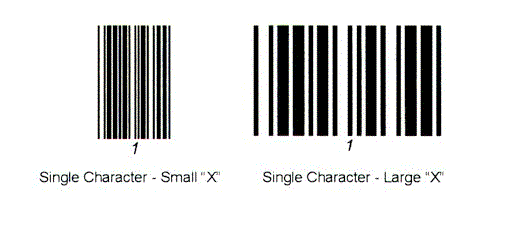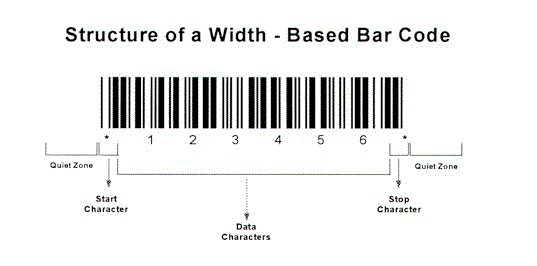

| Products | All About Bar Codes | Search | Y2K Information |
| Printers | Data Collection | Software | Point of Sale |
What is a Bar Code?
Everyday you see bar codes in the world around you. You see them in supermarkets, on labels, greeting cards and consumable goods. By now you also realize that bar codes have replaced the traditional pricing of products.
Bar
codes can be used in every business around the world. For
example: 
A bar code can best be described as an "optical Morse code." Series of black bars and white spaces of varying widths are printed on labels to uniquely identify items. The bar code labels are read with a scanner, which measures reflected light and interprets the code into numbers and letters that are passed on to a computer. Because there are many ways to arrange these bars and spaces, numerous symbologies are possible. Common linear symbologies include UPC/EAN, Interleaved 2 of 5 (I of 5), Codabar, Code 39, and Code 128.

The "X" dimension determines a bar code's density. Density refers to the amount of information that can be captured in the bar code in a particular space, usually a linear inch. While not intuitively obvious, high density bar codes have low numbers (e.g., 5 mil) and low density bar codes have high numbers (e.g., 55 mil). This is because individual characters consist of some combination of bars and spaces that are each multiples of "X". When "X" is small, the area required for each character is less than when "X" is large; thus the bar code can hold more per linear inch and is said to be of higher density. Similarly, increasing the width of the narrowest element ("X") increases the space required for each character and reduces the number of characters per inch. Because the resulting code is often quite large, very low density codes are often associated with applications such as warehousing that require reading bar codes from a significant distance (3 to 30 feet).

All bar codes have start/stop characters that allow the bar code to be read from both left to right and right to left. Unique characters placed at both the beginning and end of each bar code, the stop/start characters provide timing references, symbology identification, and direction of read information to the scanner. By convention, the unique character on the left of the bar code is considered the "start" and the character on the right of the bar code is considered the "stop."
Immediately preceding the start character and following the stop character is an area of no markings called the quiet zone. Because there is no printing in this area, a scanning signal is not produced, thus the term "quiet." The quiet zone helps the scanner find the leading edge of the bar code so reading can begin. As a rule, the quiet zone should be ten times the "X" dimension or 1/4", whichever is greater.
Putting all these components together, we get a complete bar code such as the one found below. Notice the leading quiet zone followed by a start character, data, a stop character, and a final quiet zone. Link to more detail.

Any individual can use a bar code and a scanning device to gather information, sort it and later upload the data to a computer so that a report can be printed quickly, easily identifying who did what, when and where it took place.
No other simple, easy to use product can control your workplace the way the bar code can!
Besides the lineal bar code, today's new bar codes are two dimensional, electronic or small computer chips which sort data in inconspicuous places like a credit card.
If you need to gather and manage information, people or assets, a bar code is the number one method to do so and Data ID Systems is the place to get your solution quickly and easily. We are a multi-faceted systems integration solution company using the simple bar code to decrease labor challenges and save you money.
Call us today for information or email us through this site.